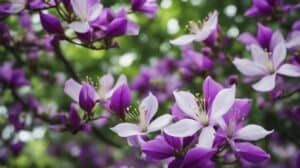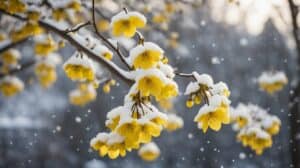Araucaria heterophylla, commonly known as the Norfolk Island Pine, is a popular indoor plant that is native to Norfolk Island in the Pacific Ocean.
This evergreen coniferous tree can grow up to 200 feet tall in its natural habitat, but when grown as a houseplant, it typically reaches a height of 6-8 feet.
The Norfolk Island Pine is a low-maintenance plant that is easy to care for, making it a great choice for novice gardeners.

In this article, we will provide a comprehensive guide on how to care for your Norfolk Island Pine.
We will cover everything from watering and fertilizing to pruning and propagation.
Whether you are a seasoned plant parent or just starting out, this guide will provide you with all the information you need to keep your Norfolk Island Pine healthy and thriving.
So, let’s dive in and learn more about this beautiful and unique indoor plant.
Understanding Araucaria Heterophylla
Species Overview
Araucaria Heterophylla, commonly known as the Norfolk Island Pine, is a unique and beautiful evergreen tree that belongs to the Araucariaceae family.
It is originally from Norfolk Island, a small island in the Pacific Ocean, and is now widely cultivated as an ornamental plant in many parts of the world.
The Norfolk Island Pine is a slow-growing tree that can reach up to 200 feet in height in its natural habitat.
However, it usually grows up to 50-100 feet in cultivation. It has a symmetrical shape and a straight trunk, with branches that grow horizontally in tiers.
The leaves are needle-like, about 1-2 inches long, and are arranged in whorls of three to six.
Natural Habitat
The Norfolk Island Pine is native to Norfolk Island, a small island located between New Caledonia and New Zealand.
It grows in a subtropical climate, with warm temperatures and high humidity.
The tree prefers well-drained soil and can tolerate salty conditions, which is why it is often planted along coastal areas.
In its natural habitat, the Norfolk Island Pine is an important part of the island’s ecosystem.
It provides shelter and food for many species of birds, including the endangered Norfolk Island Parakeet.
The tree is also used for timber and as a source of resin.
Overall, understanding the natural habitat and species overview of Araucaria Heterophylla is important for proper care and maintenance of this unique and beautiful tree.
Caring for Your Norfolk Island Pine

Light Requirements
Norfolk Island Pine prefers bright, indirect light. It should not be exposed to direct sunlight as it can cause the needles to burn.
If the plant is not getting enough light, it may start to drop its lower needles.
Consider supplementing with artificial light if the plant is not getting enough natural light.
Watering Techniques
Norfolk Island Pine likes to be kept evenly moist, but not waterlogged. Water the plant when the top inch of soil feels dry to the touch.
Be sure to allow excess water to drain away, as waterlogged soil can lead to root rot.
Soil and Fertilization
The ideal soil for Norfolk Island Pine is well-draining and slightly acidic. A soil mix of peat moss, perlite, and sand is ideal.
Fertilize the plant every two to four weeks during the growing season with a balanced, water-soluble fertilizer. Do not fertilize during the winter months.
Temperature and Humidity Control
Norfolk Island Pine prefers temperatures between 60-75°F (15-24°C). Keep the plant away from cold drafts and heat sources such as radiators.
The plant also prefers high humidity, so consider using a humidifier or placing a tray of water near the plant to increase humidity levels.
Common Issues and Solutions

Pest Management
Norfolk Island Pines are vulnerable to pests such as spider mites, mealybugs, and scale insects.
Spider mites are tiny, red-brown pests that feed on the plant’s sap, causing yellowing and browning of the needles.
Mealybugs and scale insects are white, waxy pests that also feed on the sap and cause yellowing and wilting of the needles.
To manage these pests, it is recommended to spray the plant with insecticidal soap or neem oil.
These natural remedies will not harm the plant, but will effectively eliminate the pests.
It is important to repeat the treatment every 7-10 days until the pests are completely gone.
Disease Prevention
Norfolk Island Pines are susceptible to root rot, which is caused by overwatering and poor drainage.
Root rot can cause the tree to wilt, turn yellow, and eventually die.
To prevent root rot, it is important to ensure that the plant is not sitting in water and that the soil is well-draining.
Another common disease is fungal leaf spot, which causes dark spots on the needles.
This disease can be prevented by avoiding overhead watering and ensuring proper air circulation around the plant.
If the disease has already affected the plant, it is recommended to remove the affected needles and treat the plant with a fungicide.
Needle Drop Causes
Needle drop is a common issue with Norfolk Island Pines, especially during the winter months.
This can be caused by a lack of humidity, overwatering, or underwatering.
To prevent needle drop, it is recommended to mist the plant regularly and to ensure that the soil is moist but not waterlogged.
It is also important to avoid placing the plant near drafts or heating vents, as this can cause the needles to dry out and fall off.
Overall, with proper care and attention, Norfolk Island Pines can thrive and make beautiful additions to any indoor space.
Propagation and Repotting

Propagation Methods
Araucaria Heterophylla, commonly known as the Norfolk Island Pine, can be propagated by seed or cuttings.
Seed propagation is a slow process and requires patience, as it can take up to several years for the seed to germinate and grow into a mature plant.
Cuttings, on the other hand, are a quicker and more reliable method of propagation.
To propagate Araucaria Heterophylla from cuttings, take a stem cutting from the parent plant in the spring or early summer.
The cutting should be about 4-6 inches long and have a few leaves attached to it.
Dip the cut end of the stem in rooting hormone powder and plant it in a well-draining potting mix.
Keep the soil moist and warm, and the cutting should root within a few weeks.
Repotting Steps
Araucaria Heterophylla should be repotted every 2-3 years, or when the roots have outgrown the current pot.
Repotting is best done in the spring, just before the growing season begins.
To repot, gently remove the plant from its current pot and loosen any tangled roots.
Choose a new pot that is one size larger than the current pot, and fill it with fresh potting mix.
Place the plant in the new pot and fill in any gaps with additional potting mix. Water the plant thoroughly and place it in a bright, indirect light.
It is important to avoid overwatering the plant after repotting, as this can lead to root rot.
Allow the soil to dry out slightly between waterings, and avoid letting the plant sit in standing water.
By following these propagation and repotting steps, you can ensure that your Araucaria Heterophylla stays healthy and happy for years to come.
Frequently Asked Questions

How often should I water my Norfolk Island Pine?
Norfolk Island Pines prefer moist soil but do not like to be waterlogged.
It is recommended to water them thoroughly when the top inch of soil is dry to the touch.
Avoid letting the soil dry out completely or sitting in standing water.
What is the ideal lighting for a Norfolk Island Pine indoors?
Norfolk Island Pines thrive in bright, indirect light. They can also tolerate some direct sunlight, but too much can scorch their leaves.
A north-facing window or a spot near a bright east or west-facing window is ideal.
Can Norfolk Island Pines survive cold temperatures?
Norfolk Island Pines are native to a tropical climate and do not tolerate cold temperatures well.
They should be kept in a room with a temperature range between 60-75°F (15-24°C). Avoid placing them near drafts or cold windows during the winter.
What are the common problems with Norfolk Island Pines and how can I address them?
Common problems with Norfolk Island Pines include browning of the tips of the needles, yellowing of the needles, and root rot due to overwatering.
To address browning of the tips, trim off the affected areas. To address yellowing of the needles, adjust the lighting or watering schedule.
To address root rot, reduce watering and ensure proper drainage.
How can I encourage healthy growth in my Norfolk Island Pine?
To encourage healthy growth, provide your Norfolk Island Pine with bright, indirect light and keep the soil moist but not waterlogged.
Fertilize every two to four weeks during the growing season with a balanced, water-soluble fertilizer.
What is the maximum height a Norfolk Island Pine can reach indoors?
Norfolk Island Pines can grow up to 10 feet (3 meters) tall indoors with proper care. However, they can also be pruned to maintain a smaller size.














